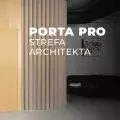It has 800 square meters of floor space, although from the outside it looks like a small mountain hut. This is the new Tatra Archive of Planet Earth, which was built at the inlet of the Koscieliska Valley. POLE Architects is behind the design of the underground education center in the Tatra Mountains.
The Tatra National Park has long been in need of an appropriate infrastructure that would allow it to carry out educational activities for the 21st century. For many years, the Nature Education Center was the answer to this need. Modernization carried out in the past decade modernized the museum located in the heart of Zakopane, adapting it to the expectations of modern audiences. However, not everyone visits Zakopane before heading out on a mountain trail, and some avoid the town like the plague, which is hardly surprising. For those who use the Koscieliska Valley as the start of their mountain trek, the Tatra National Park has opened a new educational unit, allowing them to equip themselves with specialized knowledge and better understand the processes that shaped Poland's highest mountains just before the start of the trek. Interestingly, the building itself is not tall - on the contrary, it is almost entirely underground. Why was the Tatra Archive of Planet Earth buried?
Tatra Mountains Archive of Planet Earth
Photo: Filip Bramorski © POLE Architects
how to build where you can't build? ano.... dig
The building of the Tatra Mountains Archive of Planet Earth is, for the most part, an object located below ground level. This state of affairs is due to the unique location of the TAPZ building - for this one is located in the Kiry district, in the village of Koscielisko, at the very entrance to the Koscieliska Valley. The Local Land Use Plan prepared for the area assumes a number of restrictions, which, quite rightly, prevented the erection of a large volume in this place. Among the restrictions were the low height and number of floors above ground, the need to crown the buildings with a steep pitched roof, or the maximum width of the tract, which is only 8 meters. Those wishing to build could afford a maximum of 35 square meters of floor space.
Tatra Planet Earth Archive
Photo: Filip Bramorski © POLE Architects
Even if the MPZP had not been so strict, erecting a large building in such a special location as one of the entrances to the Tatra National Park would have been a veritable crime on the landscape. For this reason, practically all the development of the Tatra Planet Earth Archive was located by the architects in the underground storey. The existence of the TAPZ is actually suggested only by a few small elements protruding above ground level.
Tatra Mountains Archive of Planet Earth
Photo: Filip Bramorski © POLE Architects
hut-shell
The most striking "aboveground" accent of the Tatra Archive of Planet Earth is a small building serving people with mobility impairments. It was erected in a form reminiscent of traditional Tatra huts, made of wood and with a gabled roof covered with shingles. The mountain hut was placed on the axis of the main entrance to the TAPZ, and the steepness of its roof repeats the outline of the top of the Front Mound, which forms a scenic backdrop for the entire composition. Despite its evocative forms, the building is essentially a blowout, as there is another largely glass structure housing an elevator.
Tatra Planet Earth Archive
Photo: Filip Bramorski © POLE Architects
rectangles, circles and squares
Concrete walls also protrude above ground level, with their shapes suggesting the layout of the rooms below ground. Here the architects decided to play with simple geometric shapes. Observing the TAPZ buildings from a bird's-eye view (or one of the nearby peaks), we see rectangular fields into which staircases plunge, or circular surrounds for skylights and light wells. When we view the education center up close the effect, of course, is not so easy to decipher. Instead, the mountain glade draws rows of low walls, on which are placed much higher than them, transparent barriers. Creating a substitute for a rocky landscape using the language of architecture is an interesting idea, but the glass barriers, which were created here presumably for safety reasons, somewhat spoil the final effect.
Tatra Planet Earth Archive
Photo: Filip Bramorski © POLE Architects
going underground
The Tatra Archive of Planet Earth opens to visitors through a monumental staircase, dug into the ground , which leads to the underground floor, which is the main part of the building. The façade, if that's what the plane enclosing the entrance part of the building can be called in this case, has been solved by means of large-scale glazing with doors, over which hangs a massive concrete cornice with the institution's logo. Just beyond the entrance, wanderers are greeted by an information desk and a checkroom. Further on there are seven exhibition halls and utility rooms. The exit of the Tatra Planet Earth Archive is inscribed in a cylindrical concrete and glass structure, much of which is sprinkled with earth and overgrown with grass. An important part of the building is also a conference room, which, although small, already serves to integrate the community of Tatra guides, who previously had no convenient place to meet together.
Tatra Planet Earth Archive
Photo: Filip Bramorski © POLE Architects
Concrete, stone, or maybe something in between?
The main material used for the building of the Tatra Mountains Archive of Planet Earth is concrete - and I don't just mean its structure, but also the facade cladding and some of the walls in the interiors. Considering the architectural and natural landscape in which the new TPN building has settled, this may seem a risky solution, after all, the area is dominated by wooden architecture, and thethe plot of land on which the TAPZ is located is, after all, located at the entrance to the Koscieliska Valley, being essentially surrounded by a mountainous landscape. The architects, however, decided to make the facade using concrete with a specially prepared formwork, the sculpture of which is an attempt to recreate the forms taken by the sedimentary rocks that build the Tatra Mountains. The effect is intriguing, though the point of such a procedure is puzzling, after all, a lot of stone was dug out of the ground during construction. It's hard to say whether it would have worked well as a facade cladding, although the failure to incorporate the building blocks that make up the Tatra Mountains into the architecture seems like a missed opportunity.
Tatra Mountains Archive of Planet Earth
Photo: Filip Bramorski © POLE Architects
The Tatras for body, soul and mind
The heart of the Tatra Archive of Planet Earth is the permanent exhibition. Its concept was prepared by a team of specialists in the geology and history of the Tatra massif. In the exhibition spaces there is a large dose of knowledge given in a chronological, but interesting and not boring way. In addition to the boards, there are mock-ups, models, fossils or sculptures depicting animals that once lived in the Tatra Mountains. In accordance with the latest trends in museology, the exhibition is multisensory - there are a considerable number of tactile elements, there are projections and recordings. The most important aspect, however, is the substantive one, because coming out of the Tatra Archive of Planet Earth we are equipped with a solid dose of knowledge, which gives mountain excursions a whole new quality. From this perspective, the Tatra Archive of Planet Earth perfectly fulfills its function, being, depending on the direction of our trek, an introduction or a summary of Tatra adventures.


















































